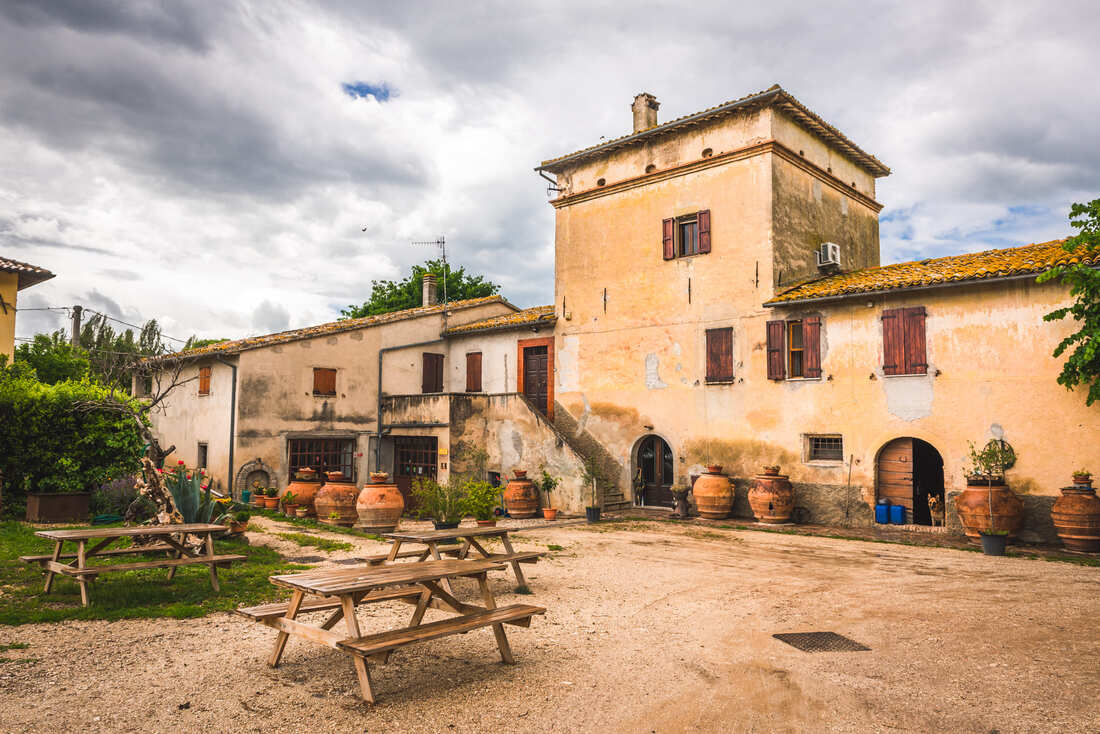by Claudia Cencini
At the ancient Carletti oil mill in Campello sul Clitunno, olive oil production is combined with the values of hospitality and Umbrian traditional cuisine.
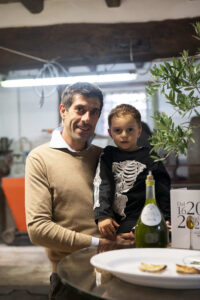 At the Carletti oil mill you can breathe a family atmosphere. As soon as you walk in you feel at home, welcomed by the warm and contagious smile of Settimio and his family, in a green oasis where time has stopped four centuries ago, without giving up the advantages offered by modern technologies applied to the ancient art of olive oil making. The paved square houses shady corners where you can sit on comfortable benches to regenerate from the noise of the daily routine and offers unexpected encounters with thriving chickens scratching around in the farmyard. But it is the oil that is the master, the undisputed king of this microcosm of family traditions and values that have survived the centuries, where quality makes the difference.
At the Carletti oil mill you can breathe a family atmosphere. As soon as you walk in you feel at home, welcomed by the warm and contagious smile of Settimio and his family, in a green oasis where time has stopped four centuries ago, without giving up the advantages offered by modern technologies applied to the ancient art of olive oil making. The paved square houses shady corners where you can sit on comfortable benches to regenerate from the noise of the daily routine and offers unexpected encounters with thriving chickens scratching around in the farmyard. But it is the oil that is the master, the undisputed king of this microcosm of family traditions and values that have survived the centuries, where quality makes the difference.
Olive oil means Umbria
The Carletti family knows this well and have made the tradition linked to the olive tree in the olive belt that goes from Spoleto to Assisi their strong point for generations.
“Our oil mill – explains Settimio – was one of the first to be established in the area, as attested by the sources and some testimonies in our possession, from the ancient oil containers dated 1700/1800 to two tiles that we still preserve bearing the date of 1701 and 1721. For our part, we try to trace the origins through a documentary investigation in the Perugia archives to retrace the birth and development of our oil mill backwards”.
A bridge between past and future
Here present and past come together, enriching each other in an interweaving that makes hospitality its strong point, starting with the camper parking area that father Carlo offers free of charge. The oil mill opens its doors to tourists, schools and visitors from all backgrounds, curious not only to taste the seasoning of bread toasted by the fireplace but to deepen the knowledge and value of traditions proudly kept alive by the managers of the oil mill. The customer becomes an integral part of the mill and its dynamics; the protagonist of a sensory adventure that involves him and makes him participate in all the processing phases in a sort of “full immersion” that triggers empathy and tickles the taste and pleasure of being together. To make the experience even more exciting the context in which it takes place.
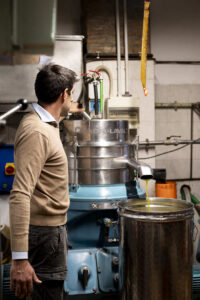 The complex, divided into several adjacent or communicating structures, retains its historical character which can be noticed in the exposed stone walls. However, young people like Settimio, who took the reins of the oil mill and shared the management of the farmhouse and the Trattoliva restaurant with his brothers, look ahead and roll up their sleeves to renew the structure and processing techniques.
The complex, divided into several adjacent or communicating structures, retains its historical character which can be noticed in the exposed stone walls. However, young people like Settimio, who took the reins of the oil mill and shared the management of the farmhouse and the Trattoliva restaurant with his brothers, look ahead and roll up their sleeves to renew the structure and processing techniques.
“We are renewing ourselves – he anticipates – to optimize and speed up production processes”. A way to keep up with the times and with an increasingly demanding and heterogeneous market, but above all without borders.
“We have increased exports,” confirms the host, “thanks to the growth in international demand, also driven by the visit of loyal foreign customers who take home not only our products, but also the brand and plan to graft it in their countries. From this year we will be present in new international markets, with a further strengthening of our presence abroad”.
From the tree to the bottle
Today, as yesterday, the harvest takes place with traditional methods, starting from October and continuing until December, closing with the traditional “benfinita” dinner.
In Umbria, olives are still largely harvested by hand, as tradition dictates. You climb the tree with a wooden ladder and manually, or with special combs, detach the olives from the branches. Alternatively, the “beating” is practiced, which consists of beating the branches with poles, the “picking” of the fruits already on the ground or mechanical harvesting with shakers that make the olives fall on nets or tarpaulins lying under the tree. After harvesting, milling is carried out within 24/48 hours. In oil mills like this the oldest method is the “pressing” with stone mills.
At Casa Carletti, the cool and basement rooms have been adapted as a showcase for exhibition and shopping, but they retain the old chestnut beams where the donkey turned the Sardinian granite millstone, now exhibited in the family-run restaurant of which it represents one of the flagships for uniqueness and historical testimony – a true museum piece. Above stands the tower of the warehouse for the storage of olives, mostly of the moraiolo and leccino type, ready to be lowered into the trapdoor for cold pressing. Everything feels as it once was, if it weren’t for a forced restyling, while fully respecting the original architectural structure.
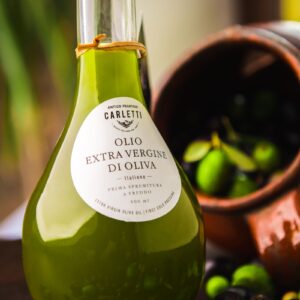
Not all olive oils are created equal
Like wine, olive oil has also evolved over the years and today it is presented at the table in a new and differentiated guise. If we talk about extra virgin olive oil, we can no longer generalize, but we need to make distinctions to choose the right oil for each dish. The Carletti oil mill has not missed the advantages of the diversified production and strength of the triad “oil mill-farmhouse-restaurant”, all strictly family-run, has emphasized the differentiation of oils to be combined with dishes to enhance the taste and flavours of Umbrian cuisine. Hence the offer of a wide range of olive-based products, which are clearly visible on the shelves of the store. We find, for example, bottles of raw, medium-fruity (Revalioso) or intense (Tancredi) olive oil, next to liqueurs based on olive leaves.
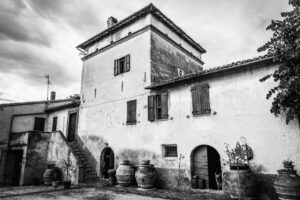
Not just olive oil
Who said that you only go to the oil mill for the oil? Today, visiting a traditional oil mill like that of the Carletti introduces the visitor to a place rich in atmospheres and scents linked to the warmth of hospitality of the past. Here, then, the event “Open Oil Mills” offers a chance to visit up close and touch the oil mill environment. As good hosts, the Carletti open their doors to those who knock even for a simple, but touching, emotional experience, to the crackling fireplace lit with a tray of steaming bruschetta that invites you to taste. Here you find yourself immersed in a family atmosphere, where family portraits suggest stories of other times, such as that of grandmother Giulia intent on rekindling the flame of the hearth or the austere and noble one of great-grandfather Carlo who was mayor of Campello. Yes, because even names are handed down from son to grandchild.
Looking around, the eye falls not only on the glittering bottles of new oil, but on the cosmetics department that has now become a flagship of the Carletti oil mill: soaps, perfumes and products for hygiene and beauty obtained from the regenerating essences of the olive oil of these stony hilly lands. The icing on the cake, in combination with olive oil in all forms, are the new discoveries based on honey and propolis, a novelty by Carletti that is having great success in the wellness market.
Info: Via Camesena 1 – Campello sul Clitunno (Pg) / Tel +39 0743 521247. /Mob. +39 366 4147494. / www.anticofrantoiocarletti.it / info@anticofrantoiocarletti.it
